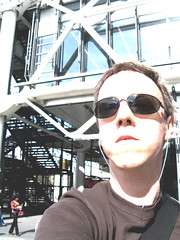Deep Visualisation
One of the key things to emerge from our work over the past few days is the critical role visualisation will play in the Creative Supercomputing initiative. While we realised some time ago that rapid visualisation of data (motion capture data, for instance) was a means of embedding clustered computing in the world of artistic practice, it's now becoming clear that we need to go far beyond this view of visualisation as a means to a creative end.
This is bound up with the need to establish a new perspective on the role of coding in arts research, and it requires a considerable mindshift to reach the point where our work is as much technology development as application. It also means exchanging competence and comfort in our current fields for a daunting learning curve and a slow process of establishing credibility in a world rightly dominated by software engineers and mathematicians.
This is a difficult transition, but it makes possible the sort of serious engagement between technological advancement and artistic practice that will be necessary to make sci-art research sustainable over the long term. In practice and in the short term it means de-emphasising surface effects and examining the nature of data sets at a deep level, trading our renderers for data mining tools. I'll be exploring the rationale and impact of this in some depth in the next few days.


0 Comments:
Post a Comment
<< Home